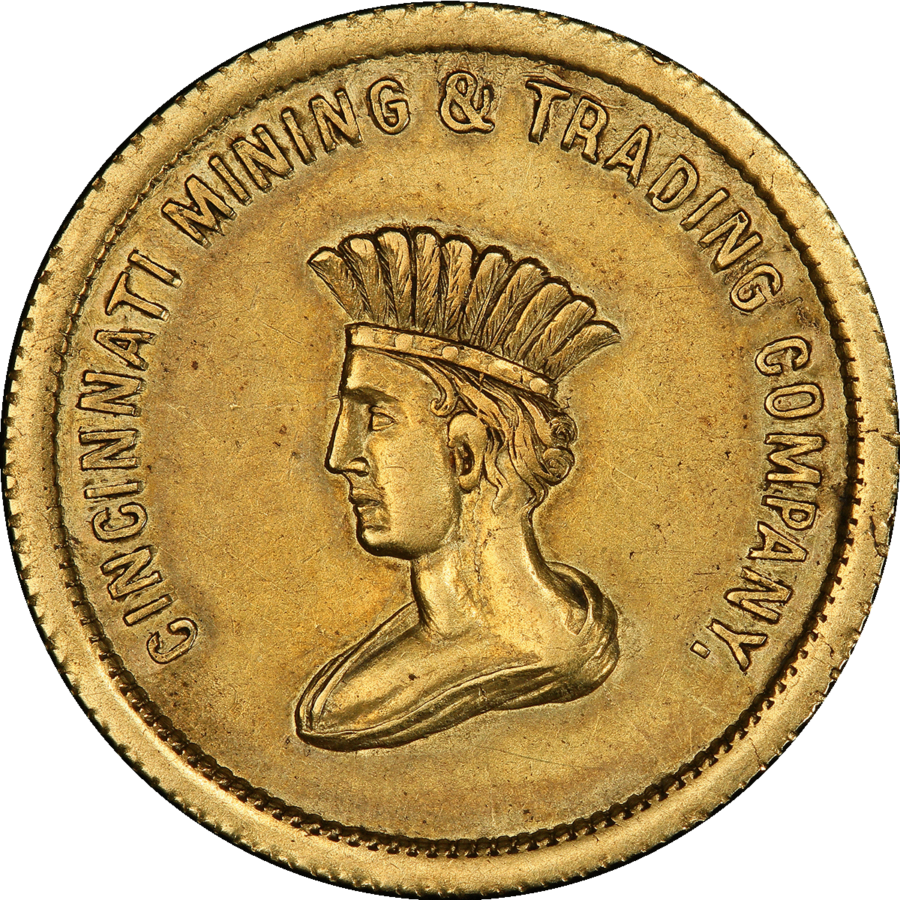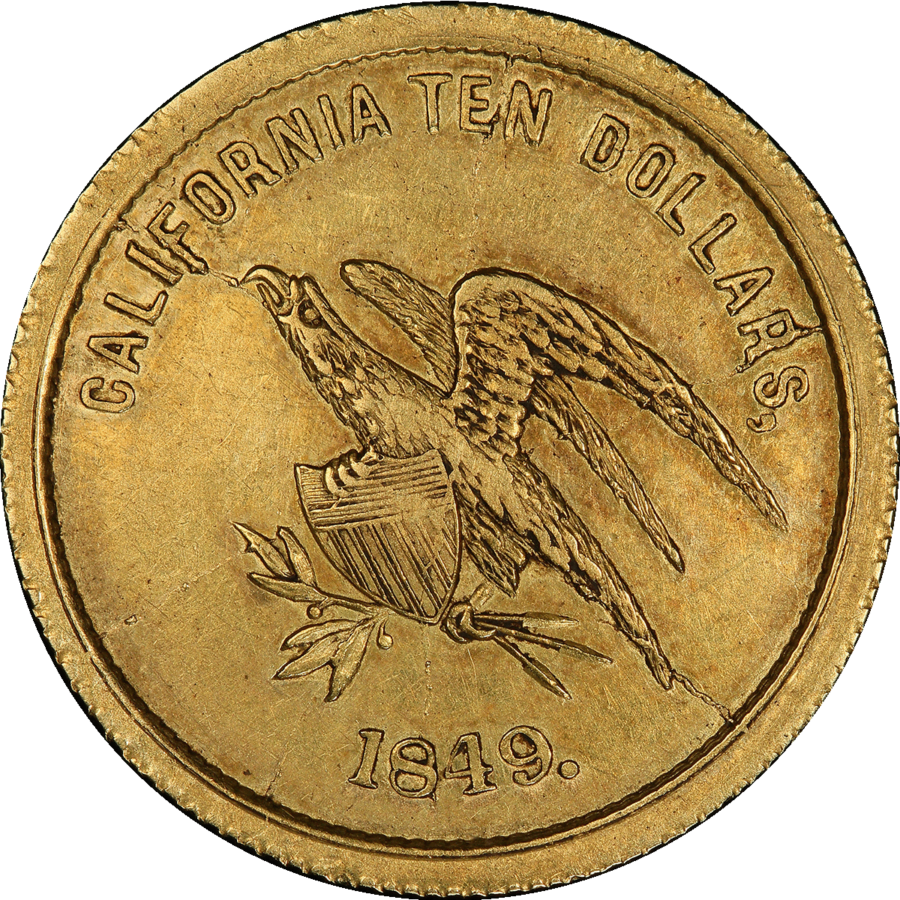Exceptionally Rare 1849 Cincinnati $10
Kagin 3 : Reeded Edge, 258.9 grains (per Ford II).
Easily among the rarest and most iconic of all Pioneer Gold coins, Cincinnati Mining & Trading Company $10s have long been near the top of want lists of every advanced Pioneer Gold collector. There is an unique Cinci $5 in the National Numismatic Collection, and only seven recorded Cinci $10s – two in the National Numismatic Collection, two formerly in the DuPont Collection, stolen in 1967, Garrett:885, Brand:1539 struck over an Ormsby $10, and this Ford:362. With only three coins of this maker available to collectors, obviously, recorded sales are few and far between.
Super-collector Virgil Brand at one time owned three of the seven recorded Cinci $10s including this coin purchased in 1908 (Brand ledger entry 43901), the coin struck over an Ormsby $10 purchased in 1914 and sold by Bowers and Merena in 1984 (Brand ledger entry 75189), and the third purchased from Henry Chapman in 1920 (Brand ledger entry 98678) that was later included in the Josiah K. Lilly Collection donated to the Smithsonian Institution in lieu of federal estate tax in 1968.
In his landmark “Private Gold Coinage of California” (1913), originally published as a series of articles in the American Journal of Numismatics, Edgar H. Adams notes the company’s formal name as “California Mining and Trading Company of Cincinnati”, and the by-laws showing a roster of 51 members, including the President J. H. Leavering.
The extreme rarity of 1849 Cincinnati $10s likely has two causes. First, the early distrust of privately minted California gold after assays performed by Jacob R. Eckfeldt and William E. Dubois at the Philadelphia Mint showed many of these coins severely short of gold for their stated denominations. While Cinci $10s were found to contain a relatively respectable $9.70 in gold, the Ormsby $10s came in at $9.37, Mormon $10s at an average of $8.60, and Pacific $10s at a dreadful $7.86. This lead to significant discounting or outright refusal of all 1849 Pioneer Gold coins regardless of maker, and a subsequent mass recoinage of most of these early issues. Secondly, the traditional reverse eagle side die collapsed, with seven radial cracks and a surface that appears to be slightly convex. Since all known Cinci $10s exhibit these die cracks, it is likely that the reverse failed early in the life of these dies and production was much lower than anticipated.
As is the case for many Pioneer Gold issues, the origin story for Cincinnati Mining Company coinage is subject to dispute. Traditionally, it has been believed that despite their good intentions, and as was the fate of many of the companies of men formed and headed west, California Mining and Trading Company of Cincinnati disbanded upon their arrival in California. Their dies and coining equipment likely found its way to the company of David C. Broderick and Frederick D. Kohler, both originally fireman from New York City.
In his “Private Gold Coins and Patterns of the United States” (1981), Don Kagin credits Broderick and Kohler, doing business as Kohler and Company, with minting the “Cincinnati Mining and Trading Company” issues, as well as those of the Miners Bank and Pacific Company. Kagin further notes:
“Kohler did the engraving and assaying, while Broderick handled the heavy manual labor of melting the dust, pouring it into bars, weighing the ingots, and hammering out the pieces of gold with the die.”
Regarding the source of the “Cincinnati Mining and Trading Company” dies, Kagin writes:
“There can be some intelligent speculation as to who made the dies for the Cincinnati Company. Nixon and Co. were paper manufacturers in Cincinnati on Walnut Street below Pearl and employed engravers on steel to create the designs for wallpaper. H. Johnson and W. Johnson of Cincinnati later engraved dies for the token cents which widely circulated during the Civil War. Since A. B. Nixon, J. Johnson, and A. Johnson were members of the Cincinnati party going to California, it is probable that the Cincinnati Company coining dies were prepared by the Johnsons in Nixon’s paper mill.”
The two finest known Cinci $10s are held in the National Numismatic Collection at the Smithsonian Institution, including the superb NNC 1985.0441.3000, followed by NNC 68.159.1113 formerly in the Lilly Collection. The two DuPont coins stolen in 1967 were once owned together by collector Charles M. Williams. The Williams Collection, while not well known today, was sold privately in 1950 for a sum reported in excess of $250,000 to Sol Kaplan and the Numismatic Gallery (Abe Kosoff and Abner Kreisberg), and included both a both a ‘reeded edge’ and ‘plain edge’ Cinci $10.
As was written of this issue by Walter Breen in his ‘Complete Encyclopedia’, “Survivors are so rare that grade is irrelevant.” In effect, the grading of coins under the Mint State levels is an attempt to convey some unstated percentage of wear, less deductions for problems. We regularly use certain focal points as short hand determinants of grade, such as wear to the letters of LIBERTY, or to the feathers on an eagle’s breast. In the case of Cinci $10s, there are no established grading standards, so we adopt those used for federal coinage of similar design. However, that presents a problem as the collapse of the reverse (eagle side) die created a coin with a slightly convex surface, an eagle’s breast that was abnormally exposed, and which took a little bit of wear more quickly than the rest of the coin. The result here is a coin with clearly AU surfaces, but with eagle’s breast feathers that our brains categorize as XF. This was a long time PCGS XF45, more recently regraded to NGC AU58, then regraded once again to PCGS AU53. It is not included in the CAC Census as they consider it to be XF45. But, as Breen inferred, it doesn’t really matter.
Of the other two remaining coins available to collectors, Garrett (1980):885 is the clear finest, certified by PCGS as AU58, and would easily bring a $1 Million+ price tag if offered today. Brand (1984):1539, struck over an Ormsby $10 with a strong undertype, was certified by PCGS as XF45 #04550802, and was included in the CAC Census, yet has now been regraded as PCGS AU53 (2022). Relative ranking of Brand (1984) and the Fishel – Brand – Ford coin noted above may be irrelevant, and come down to personal choice.
PCGS #38460274
Provenance
Jacob Fishel, privately, May 1908 at $1,750 to Virgil Brand. This was the highest price paid by Brand for a single coin up to that time. Fishel claimed to be a “descendant of a member of the company which made the pieces”. Virgil Brand, ledger entry 43901, until his death in 1926. Virgil Brand Estate, Armin W. Brand and Horace L.P. Brand equally. Horace L.P. Brand, upon final division of the Virgil Brand Estate in October 1937, until his death in May 1962. Privately, August 1963 to John J. Ford, Jr. (per Stack’s ‘Ford II’, May 2004). Stack’s ‘John J. Ford, Jr. Collection, Part II’, May 2004, lot 362 at $431,250 to Ed Milas (RARCOA). RARCOA, privately, July 2021 to Joe O’Connor (OCNUMIS) and John Albanese (CAC).


